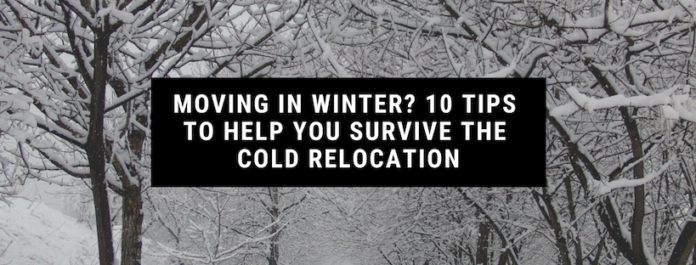Winter is an overlooked time for house hunting, but it might be the best time to buy or rent a house. Prices decline throughout the holidays as people’s social schedules get tight. Sellers are motivated to sell, and competition thins out.
If you buy in winter, though, that means you’ll be moving in winter. Organizing a move around falling temperatures and ice and snow has its own challenges.
Here are 10 winter moving tips.
1. Hire Movers
If you can afford it, outsource the job. It’s an investment in peace of mind.
Experienced movers are trained to pack up and protect your belongings. They’re fast and efficient, which matters even more when you’re hauling things outside in freezing conditions. You won’t have to worry about heavy lifting, and you won’t have to navigate an unwieldy moving truck down slick, snowy roads.
Find a licensed, reputable moving company. Check with your realtor for leads, and get a handful of quotes. Make sure they’ve been in business for at least ten years and their trucks have permanent signage.
When the day comes, celebrate your winter move by sipping hot cocoa in your stocking feet while everything falls into place around you.
2. Waterproof Your Boxes
If you’re moving without the help of a moving company, you’ll want to make sure your boxes can go the distance. Pack smart to prevent damage to your personal items.
Wet snow and a wintry mix of precipitation will do a number on the humble cardboard box. Use as many plastic bins as you can. Wrap mattresses in mattress bags.
Get waterproof labels, and contain the contents inside boxes in plastic bags and bubble wrap. Keep in mind that some items shouldn’t be exposed to the cold. Things like medicine, canned sodas and foods, even cell phones and musical instruments can suffer damage when frozen.
3. Start Early
Daylight is scarce in the winter. Get up early! Start driving while it’s still dark so you can take advantage of every moment of sunshine for the actual moving.
Don’t underestimate how much colder it gets when the sun goes down. You’ll want to soak up every extra degree in wintertime.
Not only is it colder in the dark, but it’s also just plain harder to move. It’s hard to see where you’re walking, and it’s easy to overlook boxes or objects tucked in the corners of the moving truck.
Before you start the move, make sure the exterior lights are working and replace any burned out light bulbs.
4. Turn Up the Heat
Get your utilities turned on before your moving day. Test the heat to see how long it takes to knock off the winter chill. Consider turning the heat on the night before so you show up to a somewhat warm house.
While the house is empty, it’s not a bad idea to have it audited for leaks. Get your ducts checked and have your windows and attic sealed against drafts.
5. Wear the Right Clothes
Dress for the weather.
Wear warm, water-resistant shoes. A hood will either fall off or get in the way, so put on a hat. Gloves will keep your hands warm and dry and they’ll also protect them from the harshness of handling boxes.
The physical labor of moving might warm you up a bit, so layer on clothes that can be peeled away as you adjust to the temperature.
6. Shovel the Sidewalks
Unless you’re backing the moving truck right up to a nice, roomy garage, you’ll probably be putting in miles on the sidewalks. Clear sidewalks of snow from edge to edge. You want as much walking room as possible.
Salt walkways the night before so they’re ice-free on moving day. Have a broom handy to keep things clean.
Safely remove hanging icicles. While it’s painful to hit your head on them, it can be catastrophic if a heavy icicle falls down on you.
7. Cover the Floor
Salt and moisture are terrible for floors, especially hardwoods. Cover the floor to protect it from any moving damage.
You can reuse flattened cardboard boxes. Or make a path with heavyweight builder’s paper. Tape it down with residue-free painter’s tape so it stays put.
8. Watch the Weather
Check the weather forecast for your projected moving date, and be prepared to make other plans. While it’s doable to move in a light dusting of snow, treacherous winds and blizzard-like conditions aren’t safe.
9. Winterize Your Car
Make sure your own vehicle is up for a winter journey. Get it serviced in the weeks before the move.
You’ll want your tires, wipers, and fluids checked, and you’ll also want to have some emergency supplies on hand. Put a snow shovel and ice scraper in the car, along with blankets, an emergency kit, jumper cables, and a tow rope.
10. Trash the Mess
Clean up as soon as you can. Soggy boxes make a mess of your carpets and can even attract cockroaches and other pests, especially when it’s cold outside. Salt from the roads or sidewalks can scratch wood floors and ruin the finish.
Throw away or recycle wrappers and packing materials. Wipe down plastic bins and other furnishings. Do a quick sweep, and Swiffer the floors before you collapse on the couch.
Moving in Winter Is Challenging but Doable
Moving at any time of the year can be a pain, but moving in winter has particular challenges. You’ll have to pay special attention to your packing technique and make the most of your time. You also have to take precautions to protect your floors from salt and slush.




















